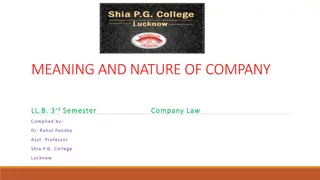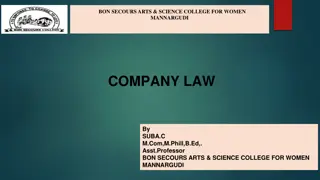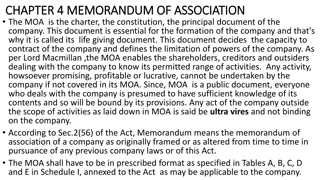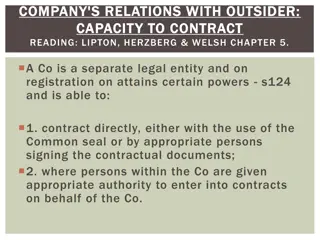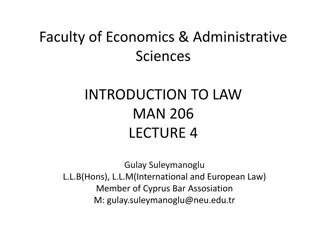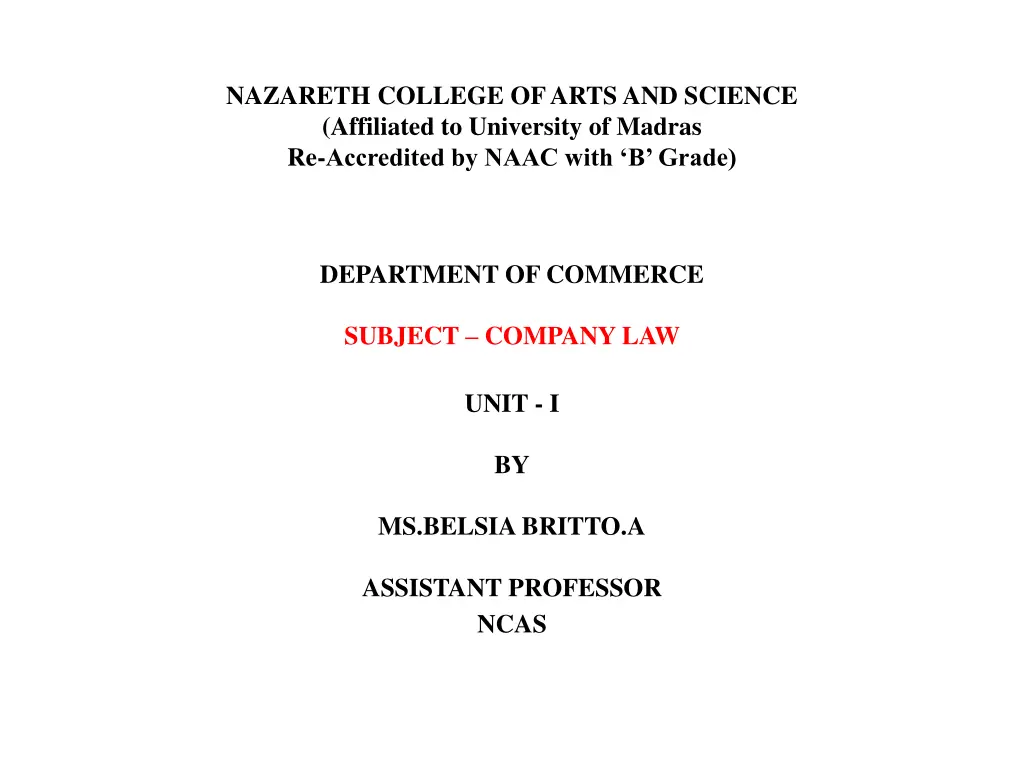
Understanding Company Law: Memorandum of Association and Contents Explained
Learn about the significance of Memorandum of Association (MOA) in company law, including its contents such as Name Clause, Registered Office Clause, Object Clause, Liability Clause, Capital Clause, and Association Clause. Discover the importance of MOA in defining a company's objectives, powers, and limitations to ensure legal compliance.
Download Presentation

Please find below an Image/Link to download the presentation.
The content on the website is provided AS IS for your information and personal use only. It may not be sold, licensed, or shared on other websites without obtaining consent from the author. If you encounter any issues during the download, it is possible that the publisher has removed the file from their server.
You are allowed to download the files provided on this website for personal or commercial use, subject to the condition that they are used lawfully. All files are the property of their respective owners.
The content on the website is provided AS IS for your information and personal use only. It may not be sold, licensed, or shared on other websites without obtaining consent from the author.
E N D
Presentation Transcript
NAZARETH COLLEGE OF ARTS AND SCIENCE (Affiliated to University of Madras Re-Accredited by NAAC with B Grade) DEPARTMENT OF COMMERCE SUBJECT COMPANY LAW UNIT - I BY MS.BELSIA BRITTO.A ASSISTANT PROFESSOR NCAS
Memorandum of Association It is the charter of the company It contains the fundamental conditions upon which the company can be incorporated It contains the objects of the company s formation The company has to act within objects specified in the MOA It defines as well as confines the powers of the company Any thing done beyond the objects specified in the MOA will be ultra vires. Their transactions will be null and void The outsider have to transact looking into the MOA
Conditions of the MOA It should be printed Divided into paragraph and numbers consecutively Signed by at least seven persons or two in case of public and private company respectively. The signature should be in the presence of a witness, who will have to attest the signature Members have to take shares and write the number of shares taken with full address
CONTENTS OF THE MOA The Name Clause it decides on the name of the company based on the capital involved The Registered Office Clause- where it has registered its head office and other branch office ( The registered office can be changed with the permission of the ROC) The Object Clause- Main object, ancillary object and the other objects of the company are clearly specified The applicable doctrine here is the Doctrine of Ultra Vires beyond the powers of the company (opposed to Intra Vires)
The Liability Clause- What is the liability of its members.. limited by shares or guarantee or unlimited, there can be alteration in the liability clause The Capital Clause - The amount of the nominal capital of the company, number of shares in which it is to be divided alteration of the capital clause etc The Association or Subscription clause- Where the subscribers to the MOA declare that they respectively agree to take the number of the shares in the capital. They have to sign in the presence of two witnesses, who attest the signatures, The subscriber to take at least one share. After the name the subscriber has to write the number of shares taken
Doctrine of Ultra Vires The powers exercisable by the company are to be confined to the objects specified in the MOA. So it is better to define and include the provisions regarding the acquiring of business, sharing of profits, promoting company and other financial, gifts , political party funds etc If the company acts beyond the powers or the objects of the company that is specified in the MOA, the acts are considered to be of ultra vires. Even if it is ratified by the all the members, the action is considered to be ineffective. Even the charitable contributions have to be based on the object clause.
Articles of Association It is the companies bye- laws or rules to govern the management of the company for its internal affairs and the conduct of its business. AOA defines the powers of its officers and also establishes a contract between the company and the members and between the members It can be originally framed and altered by the company under previous or existing provisions of law.
AOA plays a subsidiary part to the MOA Any thing done beyond the AOA will be considered to be irregular and may be ratified by the shareholders. The content of the AOA may differ from company to company as the Act has not specified any specific provisions Flexibility is allowed to the persons who form the company to adopt the AOA within the requirements of the company law The AOA will have to be conversant with the MOA, as they are contemporaneous documents to be read together. Any ambiguity and uncertainty in one of them may be removed by reference to the other.
Contents of the AOA Share capital Lien on shares Calls on shares Transfer and transmission of shares Forfeiture of the shares Surrender of the shares General meetings Alteration of the capital Directors etc.. Dividends and reserves Account and audit Borrowing powers Winding up Adoption of the preliminary contracts etc .
Doctrine of Constructive notice and Indoor Management Persons dealing with the company have to satisfy themselves. But need not know the internal irregularity. The doctrine of Constructive notice can be invoked by the company to operate against the persons dealing with the company. The outsider cannot embark, but only can acquaint upon the MOA and AOA. (Official Liquidator, Manasube &Co Pvt Lid V. Commissioner of Police)
Exceptions to the Doctrine of Where the outsider cannot claim the relief on the grounds of Indoor management Knowledge of irregularity No knowledge of articles Negligence Forgery Non- Existent authority of the company
Prospectus It is an invitation issued to the public to purchase or subscribe shares or debentures of the company. Every prospectus must be dated. The date of publication and the date of issue must be specifically stated in the prospectus. The golden rule of the prospectus is that every detail has to be given in strict and accuracy. The material facts given in the prospectus are presumed to be true
Various forms in which the prospectus can be issued. Shelf Prospectus: Prospectus is normally issued by financial institution or bank for one or more issues of the securities or class of securities mentioned in the prospectus. There can be deemed prospectus also if it is issued by the issue house Information Memorandum : It means a process, which is undertaken prior to the filing of prospectus. Even an Advertisement , that the shares are available is considered to be prospectus
Contents of the prospectus General information Capital structure Terms of present issue Management and projects Management and perception of risk factor It is compulsory to register the prospectus with the Registrar



